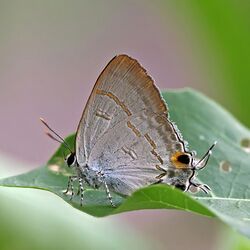Biology:Hypolycaena erylus
| Common tit | |
|---|---|

| |

| |
| H. e. teatus, Thailand | |
| Scientific classification | |
| Domain: | Eukaryota |
| Kingdom: | Animalia |
| Phylum: | Arthropoda |
| Class: | Insecta |
| Order: | Lepidoptera |
| Family: | Lycaenidae |
| Genus: | Hypolycaena |
| Species: | H. erylus
|
| Binomial name | |
| Hypolycaena erylus (Godart, 1823)
| |
| Subspecies | |
|
Many, see text | |
| Synonyms | |
| |
Hypolycaena erylus, the common tit,[1][2] is a small but striking butterfly found in India and South-East Asia[3][4] that belongs to the lycaenids or blues family. The species was first described by Jean-Baptiste Godart in 1823.
Range
Bangladesh, Nepal, Sikkim, Myanmar, Cambodia, Thailand, Laos, Vietnam, southern Yunnan, Java, Lombok, Peninsular Malaysia, Sumatra, Borneo, Andamans, Nias, Sulawesi, Philippines , Sula, Bachan, Halmahera, Obi, Bismarck Archipelago and Waigeu.[1]
Status
Common.[3][4] Not rare as per Haribal.[5]
Description
The underside of both sexes is pale greyish brown. The underside hindwing does not have a spot in the basal area of 7. The butterfly has two tails – a 6 mm long one at V1 and a 5 mm long tail at V2. The markings include:[5]
- a double bar at end-cell
- a regular discal line on the forewing
- a broken, less regular line on the hindwing
The male butterfly is pale blue to dark brown above, dark shining purple depending on the light. It has a black border with the upper forewing having a large black discal area of modified scales.[5]
The female butterfly is dark brown and its hindwing has a white disconnected discal band above the tornus. The butterfly also has a white-edged tornal black spot in 2.[5]
-
Underside
-
Upperside
-
Upperside left, underside right
Subspecies
The butterfly has a number of subspecies of which one, H. e. himavantus (Fruhstorfer), is found in mainland India while another H. e. andamana Moore is found in the Andamans.[5] All subspecies are:
- H. e. erylus (Java)
- H. e. pupienus Fruhstorfer, 1912 (Lombok)
- H. e. teatus Fruhstorfer, 1912 (southern Thailand, Peninsular Malaya, Sumatra, Borneo)
- H. e. himavantus Fruhstorfer, 1912 (Nepal, Sikkim to Myanmar, Thailand, Laos, Vietnam, southern Yunnan)
- H. e. andamana Moore, 1877 (Andamans)
- H. e. syphax Fruhstorfer, 1912 (Nias)
- H. e. gamatius Fruhstorfer, 1912 (Sulawesi) (= H. e. pigres Fruhstorfer, 1912 (Obi))
- H. e. tmolus C. Felder & R. Felder, 1862 (Philippines)
- H. e. orsiphantus Fruhstorfer, 1912 (Philippines: Basilan)
- H. e. aimnestus Fruhstorfer, 1912 (Palawan)
- H. e. georgius Fruhstorfer, 1912 (Sula)
- H. e. thyrius Fruhstorfer, 1912 (Bachan, Halmahera)
- H. e. moutoni Ribbe
- H. e. figulus Fruhstorfer, 1912 (Waigeu)
- H. e. erna Kalis, 1933 (Bismarck Archipelago)
Habits
The butterfly is abundant at low elevations. Males are known to cluster at damp patches while the females are rarely seen.[5]
Food plants
Recorded on Meyna pubescens in India.[5]
Gallery
-
H. e. gamatius male
-
H. e. gamatius female
-
H. e. thyrius male
-
H. e. thyrius female
-
Unknown male subspecies
-
Unknown female subspecies
-
Unknown female subspecies
See also
- List of butterflies of India
- List of butterflies of India (Lycaenidae)
Cited references
- ↑ 1.0 1.1 Savela, Markku (18 December 2018). "Hypolycaena erylus (Godart, [1824)"]. https://www.nic.funet.fi/pub/sci/bio/life/insecta/lepidoptera/ditrysia/papilionoidea/lycaenidae/theclinae/hypolycaena/#erylus.
- ↑ Beccaloni, G.; Scoble, M.; Kitching, I. et al., eds (2003). "Hypolycaena erylus". The Global Lepidoptera Names Index. Natural History Museum. https://www.nhm.ac.uk/our-science/data/lepindex/detail/?taxonno=196616.
- ↑ 3.0 3.1 Evans, W. H. (1932). The Identification of Indian Butterflies (2nd ed.). Mumbai, India: Bombay Natural History Society. p. 294, ser no H80.3.
- ↑ 4.0 4.1 Wynter-Blyth, Mark Alexander (1957). Butterflies of the Indian Region. Bombay, India: Bombay Natural History Society. pp. 253–254. ISBN 978-8170192329. https://books.google.com/books?id=yEkgAQAAMAAJ.
- ↑ 5.0 5.1 5.2 5.3 5.4 5.5 5.6 Haribal, Meena (1992). The Butterflies of Sikkim Himalaya and Their Natural History. Gangtok, Sikkim, India: Sikkim Nature Conservation Foundation. p. 107.
References
- Bingham, C. T. (1907). The Fauna of British India, Including Ceylon and Burma: Butterflies Volume II. London: Taylor and Francis, Ltd.. https://archive.org/details/butterflies02bingiala.
- Evans, W. H. (1932). The Identification of Indian Butterflies (2nd ed.). Mumbai, India: Bombay Natural History Society.
- Haribal, Meena (1992). The Butterflies of Sikkim Himalaya and Their Natural History. Gangtok, Sikkim, India: Sikkim Nature Conservation Foundation.
- Wynter-Blyth, Mark Alexander (1957). Butterflies of the Indian Region. Bombay, India: Bombay Natural History Society. ISBN 978-8170192329. https://books.google.com/books?id=yEkgAQAAMAAJ.
Wikidata ☰ Q5959784 entry
 |










